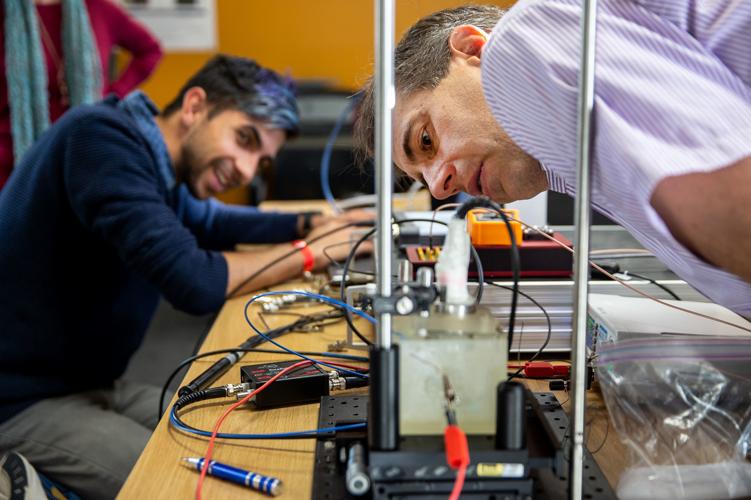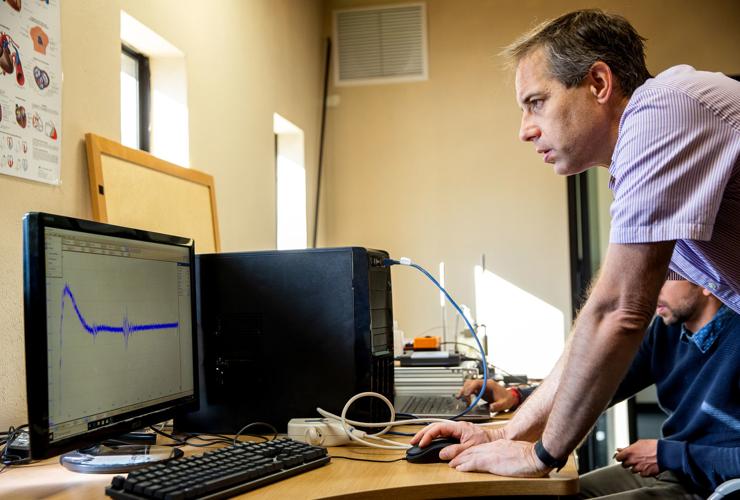Scientists at the University of Arizona are working to commercialize a new type of diagnostic imaging system that uses ultrasound to create a map of the heart’s electrical activity.
Russell Witte, a UA professor of medical imaging, optical sciences and biomedical engineering, has co-founded a Tucson-based company, ElectroSonix LLC, to develop his noninvasive method for acoustoelectric cardiac imaging and bring it to market.
Based on initial research Witte conducted on acoustoelectric imaging to map the brain, the patented heart imaging technology will allow surgeons to view precise, real-time electrical data before, during and after procedures, such as cardiac ablation to destroy tissue causing abnormal heart rhythms.
By using ultrasound signals to measure the density of bodily electrical current, Witte’s system can produce higher-resolution images than current cardiac imaging technologies, like electroanatomical mapping, fluoroscopy and echocardiography.
Witte, who earned a bachelor’s degree in physics from the UA in 1993, began studying acoustoelectric imaging as a doctoral student while earning a Ph.D. in biomedical engineering at Arizona State University in 2002.
“I was interested in different technologies for imaging the brain really on the academic side, we weren’t looking at starting a company or industry,” Witte said. “There was interest in developing ways we could look at the brain and be more non-invasive and still get good resolution.”
Witte got his doctorate in biomedical and neural engineering from Arizona State University in 2002.
He went to the University of Michigan, where he studied acoustoelectric brain imaging on his way to earning another Ph.D. in biomedical engineering and ultrasound from Michigan in 2007.
“When we thought this could be a cool idea for different applications for looking at electrical current in the body, we realized the heart was clearly the first application for this technology,” he said. “In many ways, the entire body is electrical.”
Witte brought his research to the UA when he joined the faculty in 2007, and in 2009 he won the first of a series of grants from the National Institutes of Health to study acoustoelectric imaging for heart arrhythmia, which affects more than 4 million people in the U.S.
Help from the UA
Witte brought his invention to Tech Launch Arizona, the school’s technology commercialization arm, which helped him develop the concept and secure key patents.
ElectroSonix has licensed patents on the acoustoelectric technology from the UA and from the University of Michigan, where Witte co-invented some of the core technology with research colleague Ragnar Olafsson, who also spent two years as a postdoctoral researcher at the UA and now is main systems engineer for a San Diego-based medical startup.
TLA also helped Witte find management talent to help get ElectroSonix off the ground.
Sonia Vohnout, a UA engineering alumna and longtime technology business consultant, came on board as a co-founder and chief operating officer for ElectroSonix in 2017.
Vohnout was a member of TLA’s network of commercialization partners – executives, many of them UA alumnus, who consult and sometimes take management positions in UA startups.
Eric Smith, then head of TLA’s commercialization network, knew that Vonhout’s husband had suffered heart problems and suggested she’d be a good match for ElectroSonix.
Vonhout said she was immediately interested, noting that her husband has undergone a series of treatments for several heart conditions — including five ablation procedures that didn’t cure his arrhythmia.
ElectroSonix’s technology could help, by making ablation treatments more targeted and effective, she said.
“Let’s be more target-oriented, where we can localize precisely the location of those arrhythmias in real time and then improve the patient outcome and reduce the number of surgeries,” said Vonhout, who has consulted for medical startups in the past.
Vohnout got her master’s degree in systems engineering from the UA in 1990. Her resume includes software and systems work at IBM’s storage systems division in Tucson, Tucson-based Modular Mining and Tucson-based Ridgetop Group.
She launched a business consultancy focused on government grant support for tech startups, OppSpot, in 2015.
A growing market
Vohnout said the cardiac imaging device market is already a $4.5 billion market globally and is growing.
“There are millions of patients who suffer from these arrhythmias, and for about 50% of them, the drugs don’t work, so you’ll end up performing some kind of surgery like ablation,” she said. “The impact on reducing the number of procedures could be in the billions (of dollars) in savings to the industry and of course, the patient.”
ElectroSonix’s current focus is cardiac imaging, but Witte and Vohnout say they will be exploring other opportunities in the future, after licensing UA patents for acoustoelectric imaging for both the heart and brain.
Besides securing patents and arranging licensing, Tech Launch Arizona has provided Witte and Vonhout with market research, financial analysis, business-pitch preparation, and funding for invention development through its asset-development program.
Witte and Vohnout took part in the TLA-hosted I-Corps program, a National Science Foundation program that helps academic researchers find market opportunities for their inventions.
ElectroSonix also recently joined the UA Center for Innovation, a tech business incubator at the UA Tech Park though it has its own small office near campus.
Funding the future
Meanwhile, the company is concentrating on refining its acoustoelectric imaging system and winning new grant funding to help fund development.
In 2018, ElectroSonix won a Phase I Small Business Innovation Research grant of about $225,000 from the National Heart, Lung and Blood Institute to further develop its acoustoelectric imaging system for heart arrhythmia.
The company also recently hired Rocky Arnold, a longtime Ph.D. engineer and technology business consultant based in the San Francisco Bay Area, as its CEO and principal investigator. Alexander Alvarez, a UA medical student and doctoral researcher, has been helping Witte perfect the imaging system since 2017. He now works as an engineer for the company.
The company still needs time and money to bring its imaging system to market.
Witte said at some point the company may seek private equity funding such as individual “angel” private-equity investment and perhaps eventually, venture-capital funding, but for now the company is using grant money to develop its imaging system.
And while it typically takes several years to take a medical device through clinical trials and win federal approval, Witte said he believes the company can qualify for a fast-track approval process allowed by the U.S. Food and Drug Administration for devices that are substantially based on technology that already has been approved. That could cut the time in required trials from several years to as little as a year, Witte said. Witte said the company is developing an imaging platform that could be adapted to diagnostics beyond the heart and brain, so it could move forward with certain applications on its own and license out or partner with large device makers on others.
“We do see more than one thing that could come out of our company,” he said.






